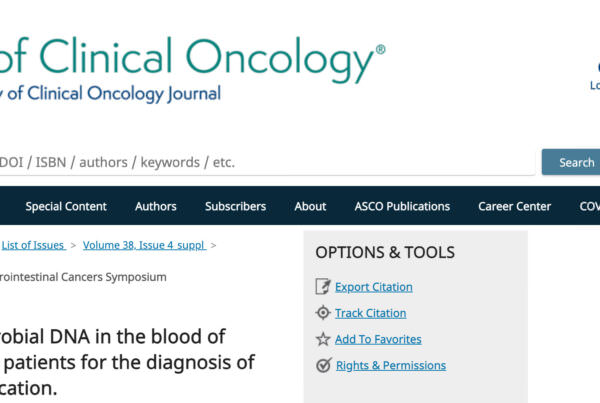Authors
Enric Domingo, PhD; Caroline Kelly, PhD; Jennifer Hay, PhD; Owen Sansom, PhD; Noori Maka, MD; Karin Oien, MDTim Iveson, MD; Mark Saunders, MD; Rachel Kerr, PhD; Ian Tomlinson, PhD; Joanne Edwards, PhD; Andrea Harkin, BSc ;Marta Nowak, PhD, DVM; Viktor Koelzer, MD; Alistair Easton, PhD; Ioannis Boukovinas, MD ; Eleni Moustou, MD10;Ippokratis Messaritakis, MD11 ; Maria Chondrozoumaki, MD12; Michaela Karagianni, MD; Franck Pages, PhD; Fanny Arnoux, PhD;Christelle Lautard, BSc; Yoann Lovera, BSc; Isabelle Boquet, PhD; Aurelie Catteau, PhD; Jerome Galon, PhD; TransSCOTConsortium; Ioannis Souglakos, MD; and David N. Church, DPhil
Purpose Immunoscore (IS) is prognostic in stage III colorectal cancer (CRC) and may predict benefit of duration (6 v 3 months) of adjuvant infusional fluorouracil, leucovorin, and oxaliplatin (FOLFOX) chemotherapy. We sought to determine IS prognostic and predictive value in stage-III CRC treated with adjuvant FOLFOX or oral capecitabine and infusional oxaliplatin (CAPOX) in the SCOT and IDEA-HORG trials.
Methods Three thousand sixty-one cases had tumor samples, of which 2,643 (1,792 CAPOX) were eligible for IS testing. Predefined cutoffs (IS-Low and IS-High) were used to classify cases into two groups for analysis of disease-free survival (3-year DFS) and multivariable-adjusted hazard ratios (mvHRs) by Cox regression.
Results IS was determined in 2,608 (99.5%) eligible cases, with 877 (33.7%) samples classified as IS-Low. IS-Low tumors were more commonly high-risk (T4 and/or N2; 52.9% IS-Low v 42.2% IS-High; P < .001) and in younger patients (P 5 .024). Patients with IS-Low tumors had significantly shorter DFS in the CAPOX, FOLFOX, and combined cohorts (mvHR, 1.52 [95% CI, 1.28 to 1.82]; mvHR, 1.58 [95% CI, 1.22 to 2.04]; and mvHR, 1.55 [95% CI, 1.34 to 1.79], respectively; P < .001 all comparisons), regardless of sex, BMI, clinical risk group, tumor location, treatment duration, or chemotherapy regimen. IS prognostic value was greater in younger (≤65 years) than older (>65 years) patients in the CAPOX cohort (mvHR, 1.92 [95% CI, 1.50 to 2.46] v 1.28 [95% CI, 1.01 to 1.63], PINTERACTION 5 .026), and in DNA mismatch repair proficient than deficient mismatch repair disease (mvHR, 1.68 [95% CI, 1.41 to 2.00] v 0.67 [95% CI, 0.30 to 1.49], PINTERACTION 5 .03), although these exploratory analyses were uncorrected for multiple testing. Adding IS to a model containing all clinical variables significantly improved prediction of DFS (likelihood ratio test, P < .001) regardless of MMR status.
Conclusion ΙΤ is prognostic in stage III CRC treated with FOLFOX or CAPOX, including within clinically relevant tumor subgroups. Possible variation in IS prognostic value by age and MMR status, and prediction of benefit from extended adjuvant therapy merit validation
© 2020 American Society of Clinical Oncology
View full article:




